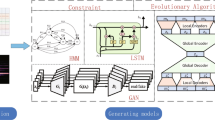Abstract
The discovery of frequent musical patterns (motifs) is a relevant problem in musicology. This paper introduces an unsupervised algorithm to address this problem in symbolically-represented musical melodies. Our algorithm is able to identify transposed patterns including exact matchings, i.e., null transpositions. We have tested our algorithm on a corpus of songs and the results suggest that our approach is promising, specially when dealing with songs that include non-exact repetitions.





Similar content being viewed by others
References
Agrawal, R., & Srikant, R. (1994). Fast algorithms for mining association rules in large databases. In 20th int. conf. on very large data bases (pp. 487–499).
Aucouturier, J. J., & Sandler, M. (2002). Finding repeating patterns in acoustic musical signals: Applications for audio thumbnailing. In Audio engineering 22nd int. conf. on virtual, synthetic and entertainment audio (AES22) (pp. 412–421).
Bartsch, M., & Wakefield, G. (2005). Audio thumbnailing of popular music using chroma-based representations. IEEE Transactions on Multimedia, 7(1), 96–104.
Berzal, F., Fajardo, W., Jiménez, A., & Molina-Solana, M. (2009). Mining musical patterns: Identification of transposed motives. In 18th Int. symposium of foundations of intelligent systems. Lecture Notes in Computer Science, vol. 5722, pp. 271–280.
Böckenhauer, H. J., & Bongartz, D. (2007). Algorithmic aspects of bioinformatics. New York: Springer.
Cambouropoulos, E., Crawford, T., & Iliopoulos, C. S. (2001). Pattern processing in melodic sequences: Challenges, caveats and prospects. Computers and the Humanities, 35(1), 9–21.
Chu, S., & Logan, B. (2002). Music summary using key phrases. In IEEE Int. Conf. on Acoustics, Speech and Signal Processing (ICASSP-00) (pp. 749–752).
Dong, G., & Pei, J. (2007). Sequence data mining (advances in database systems). New York: Springer.
Grachten, M., Arcos, J. L., & de Mantaras, R. L. (2004). Melodic similarity: Looking for a good abstraction level. In 5th Int. Conf. on Music Information Retrieval (ISMIR 2004) (pp. 210–215).
Han, J., & Kamber, M. (2005). Data mining: Concepts and techniques. Denver: Morgan Kaufmann.
Hsu, J. L., Liu, C. C., & Chen, A. (1998). Efficient repeating pattern finding in music databases. In ACM 7th int. conf. on information and knowledge management (pp. 281–288).
Jiang, L., & Hamilton, H. J. (2003). Methods for mining frequent sequential patterns. In Advances in artificial intelligence, Lecture of Notes in Computer Sciences (Vol. 2671/2003, pp. 486–491). Berlin: Springer.
Jimenez, A., Berzal, F., & Cubero, J. C. (2009). Mining induced and embedded subtrees in ordered, unordered, and partially-ordered trees. Knowledge and Information Systems, 4994/2008, 111–120. doi:10.1007/s10115-009-0213-3.
Levy, M., & Sandler, M. (2008). Structural segmentation of musical audio by constrained clustering. IEEE Transactions on Audio, Speech, and Language Processing, 16(2), 318–326.
Meredith, D., Lemström, K., & Wiggins, G. A. (2002). Algorithms for discovering repeated patterns in multidimensional representations of polyphonic music. Journal of New Music Research, 31(4), 321–345
Narmour, E. (1992). The analysis and cognition of melodic complexity: The implication realization model. Chicago: Univ. Chicago Press.
Paulus, J., & Klapuri, A. (2009). Music structure analysis using a probabilistic fitness measure and a greedy search algorithm. IEEE Transactions on Audio, Speech, and Language Processing, 17(6), 1159–1170.
Pei, J., Han, J., Asl, M. B., Pinto, H., Chen, Q., Dayal, U., et al. (2001). Prefixspan: Mining sequential patterns efficiently by prefix-projected pattern growth. In 5th int. conf. on extending database technology (pp. 215–224).
Pienimäki, A. (2002). Indexing music databases using automatic extraction of frequent phrases. In 3rd int. conf. on music information retrieval (pp. 25–30).
Rolland, P. Y. (1998). Discovering patterns in musical sequences. Journal of New Music Research, 28(4), 334–350
Srikant, R., & Agrawal, R. (1996). Mining sequential patterns: Generalizations and performance improvements. Extending Database Technology, 1057, 3–17.
Wang, W., Yang, J., & Yu, P. S. (2001). Meta-patterns: Revealing hidden periodic patterns. In IBM research report (pp. 550–557).
Yang, J., Wang, W., & Yu, P. S. (2001). Infominer: mining surprising periodic patterns. In 7th ACM int. conf. on knowledge discovery and data mining (SIGKDD) (pp. 395–400). New York: ACM
Zaki, M. J. (2001). Spade: an efficient algorithm for mining frequent sequences. Machine Learning, 42, 31–60.
Zaki, M. J. (2005a) Efficiently mining frequent embedded unordered trees. Fundamenta Informaticae, 66(1–2), 33–52
Zaki, M. J. (2005b). Efficiently mining frequent trees in a forest: Algorithms and applications. IEEE Transactions on Knowledge and Data Engineering, 17(8), 1021–1035.
Zhang, T., & Samadani, R. (2007). Automatic generation of music thumbnails. In Proceedings of the 2007 IEEE int. conf. on multimedia and expo (pp. 228–231).
Acknowledgements
F. Berzal and A. Jiménez are supported by the projects TIN2006-07262 and TIN2009-08296, whereas W. Fajardo and M. Molina-Solana are supported by the research project TIN2006-15041-C04-01.
Author information
Authors and Affiliations
Corresponding author
Rights and permissions
About this article
Cite this article
Jiménez, A., Molina-Solana, M., Berzal, F. et al. Mining transposed motifs in music. J Intell Inf Syst 36, 99–115 (2011). https://doi.org/10.1007/s10844-010-0122-7
Received:
Revised:
Accepted:
Published:
Issue Date:
DOI: https://doi.org/10.1007/s10844-010-0122-7




